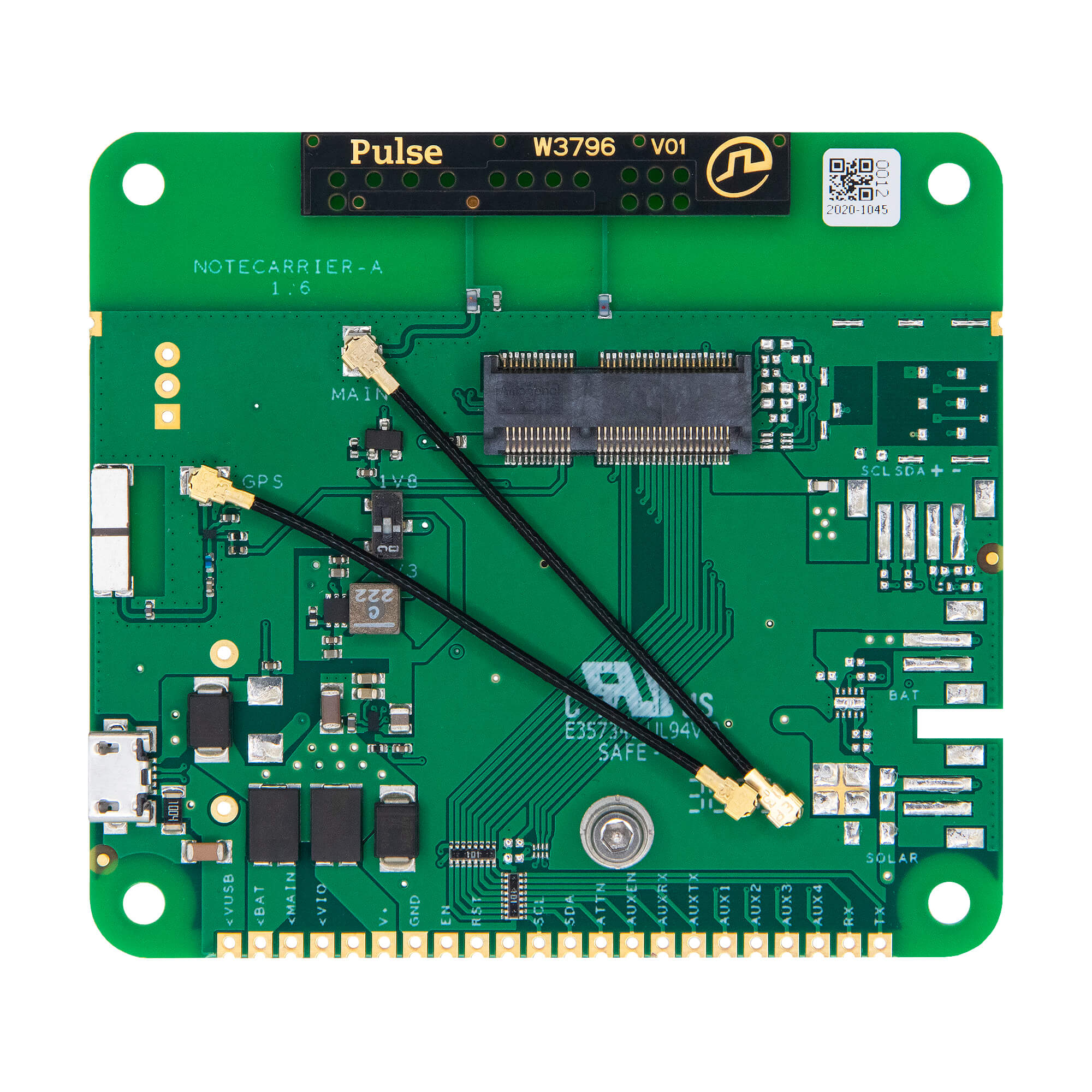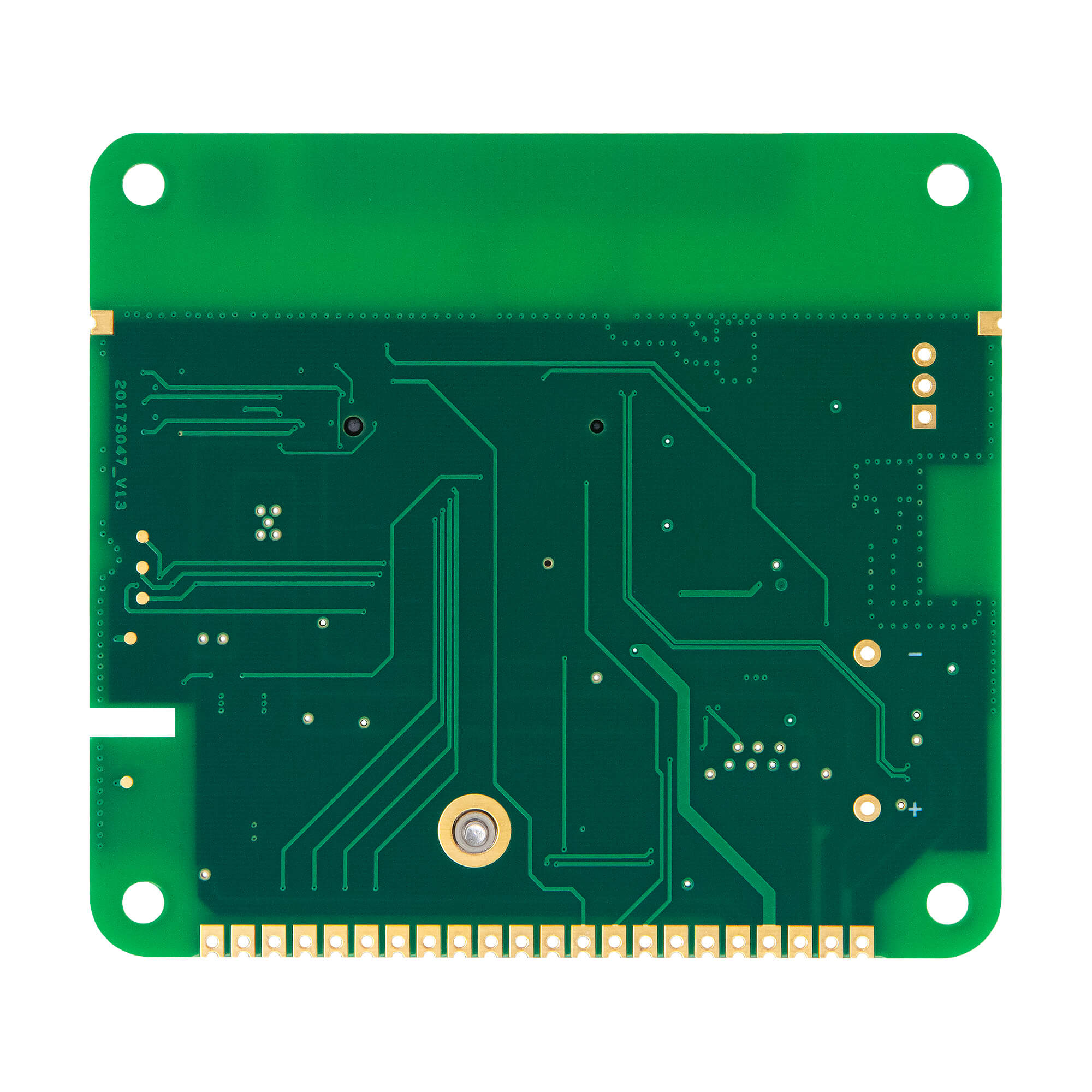Blues Notecarrier® Datasheet: Notecarrier AE
Select a SKU
Notecarrier A Series
Notecarrier B Series
Notecarrier F Series
Notecarrier Pi Hat Series
Notecarrier X Series
Legacy Notecarriers
- Notecarrier AA
- Notecarrier AE
- Notecarrier AF
- Notecarrier AL
Companion development boards for easy prototyping and deployment.
 warning
warningWhile this product is still supported, it is no longer available for purchase from the Blues store. We recommend the Notecarrier A as an updated, equivalent alternative.
Notecarriers are available in several form-factors to facilitate rapid prototyping. Depending upon the variant, a Notecarrier may be designed with direct host integration, size optimization, integrated cellular/Wi-Fi and GNSS antennas, or even to be soldered directly into a solution for low-volume production.
Functional Description
Notecarriers are designed to bridge the gap between prototype and production for the Notecard. The Notecard is designed to be socketed directly onto the circuit board using an edge connector socket, along with a customer's MCU, sensors, and controls. While such a model provides a highly modular configuration for the final product, it can make prototyping unnecessarily difficult.
Notecarriers offer breakout connections for the Notecard, as well as circuitry to provide power management, protection and signal amplification.
Features
- Simple. Provides breadboard compatible pins or solderable mask for direct connections.
- Compatible. Level shifters ensure compatibility with 3.3V or 5V equipment.
- Convenient. Powered by a USB connector (requires 2A supply).
- GPS Ready. Models are either active GPS compatible, or feature a built-in antenna to enable GNSS connectivity.
Compatible Notecards
Due to differences in the physical size of Notecards, certain Notecarriers are only compatible with certain Notecards. The Notecarrier AE is compatible with:
Package Configuration
Notecarrier AE (Antenna + Embedded Design)
Notecarrier AE (CARR-AE) is designed for embedding the Notecard and Notecarrier directly into your product.
| Front | Back |
|---|---|
 |  |
- Uses the Notecarrier AE 22-pin header.
- Notecard edge connector socket and mounting screw receptacle.
- Micro-USB port to power Notecarrier and provide a USB Serial command interface to Notecard.
- Onboard cellular/Wi-Fi and active GPS antennas.
- Castellated edge connector can be soldered directly onto a product PCB.
- PCB Dimensions: 68mm x 75mm
- Center of Mounting Holes: 59mm x 66mm (measured from the edge of the PCB to the center of the furthest mounting hole)
Power Information
All Notecarriers can be powered by connecting directly to the USB port. However, most installations will not have USB power available, so several alternate power options are provided by the various Notecarrier models:
-
attaching a LiPo battery.
The LiPo battery must be a single-cell 3.7V battery with a 2-pin JST PH connector.
-
attaching a solar cell (must be accompanied by LiPo).
The solar charging circuit is designed for use with a 4.5-7V solar panel.
-
applying 2.5-5.5VDC to the
V+pin.Commonly provided via DC power supply or non-rechargeable battery.
 warning
warningTypical USB ports may only be capable of supplying 500 mA of current, which might not be enough to power Notecard during a cellular connection to a GSM network (which can spike to 2A). In this situation, you're advised to supplement power to your Notecarrier with an external source (e.g. a LiPo battery).
GPS (GNSS) Antenna Requirements
All Notecarrier models are designed to support active GPS, and several Notecarrier models provide built-in antennas ready to be connected to a Cellular Notecard using the included U.FL cables.
Active GPS Onboard Antenna
The Notecarrier A models feature built-in, active GPS antennas and are designed with a sufficient buffer to isolate the antenna and minimize interference with the other electronics. Notecarrier A models do not support external active (powered) GPS antennas.
Header Descriptions
Notecarrier AE 22-Pin Header
| Pin Name | Direction | Usage |
|---|---|---|
| <VUSB | IN/OUT | Direct connect to VUSB pin of the USB connector |
| <BAT | IN/OUT | Direct connect to the + pin of the battery connector |
| <MAIN | OUT | Diode union of VUSB, VBAT, and V+ sources |
| <VIO | OUT | Digital I/O voltage source with 100mA available |
| V+ | IN | 2.5-5.5V, < 8µA@5V idle, < 500mA typical, 2A surge max (GPRS) |
| GND | IN | Ground |
| EN | IN | For On/Off switching of customer product. Leave NC or connect to a physical switch or Open Drain output. Notecard will be OFF if pulled to GND. Never apply positive voltage to this pin. |
| RST | IN | For development use only: MUST normally be NC or High Impedance and must never be pulled to GND. A VIO-level pulse of >250ms will reset the Notecard. |
| SCL | IN/OUT | I2C clock request interface (Notecard has onboard 10K pull-up resistors) |
| SDA | IN/OUT | I2C data request interface (Notecard has onboard 10K pull-up resistors) |
| ATTN | OUT | Configurable interrupt signal |
| AUXEN | IN/OUT | API-selectable modes of operation |
| AUXRX | IN/OUT | API-selectable modes of operation |
| AUXTX | IN/OUT | API-selectable modes of operation |
| AUX1 | IN/OUT | API-selectable modes of operation |
| AUX2 | IN/OUT | API-selectable modes of operation |
| AUX3 | IN/OUT | API-selectable modes of operation |
| AUX4 | IN/OUT | API-selectable modes of operation |
| RX | IN | UART serial receive request interface (Notecard has onboard 10K pull-up resistors) |
| TX | OUT | UART serial transmit request interface |
Specifications
Electrical Characteristics
DC Characteristics
| Description | Minimum | Maximum | Unit |
|---|---|---|---|
| Supply Voltage | 2.5 | 5.5 | V |
| Supply Current | 500 | 2000 | mA |
Absolute Maximum Ratings
| Description | Minimum | Maximum | Unit |
|---|---|---|---|
| Storage temperature | -35 | 70 | °C |
 note
noteActual values may vary based on local conditions such as atmospheric conditions and distance to the cell tower.
Ordering Information
Design Files
Open source hardware designs for all Notecarriers are maintained in the note-hardware GitHub repository.
Terms and Conditions
Visit Blues Hardware Terms & Conditions.
Revision History
| Author | Date | Summary |
|---|---|---|
| Ray Ozzie | 2019-2020 | Document drafted |
| John Wiedey | 2020 | Various improvements |
| Sean Taylor | 2020 | Various improvements |
| Zachary J. Fields | 01 OCT 2020 | Updated information and translated to markdown |
| Brandon Satrom | 04 JAN 2021 | Added link to design resources |
| Greg Wolff | 13 JAN 2021 | Added BAT pin information to Notecarrier AF datasheet |
| Brandon Satrom | 07 APR 2022 | Added Notecarrier A information |
| Zachary J. Fields | 20 JUL 2022 | Added Notecarrier F information |
| Zachary J. Fields | 24 OCT 2022 | Added Notecarrier B v2 information |
| Rob Lauer | 28 OCT 2022 | Added versioning for Notecarrier B v1/v2 |
| TJ VanToll | 05 JAN 2023 | Added Notecard Outboard Firmware Update information |
| Rob Lauer | 28 FEB 2023 | Re-labeling Notecarrier B as "Basic" |
| Rob Lauer | 01 MAR 2023 | Added PCB/Mounting Hole Dimensions |
| Rob Lauer | 07 SEP 2023 | Added Notecarrier F v1.3 information |
| Rob Lauer | 16 NOV 2023 | Added Notecarrier Pi v2.0 information |
| Rob Lauer | 14 MAR 2024 | Added Notecarrier B v3.1 and Notecarrier R v1.0 information |
| Rob Lauer | 05 JUN 2024 | Added Notecarrier XS v1.1 information |
| Rob Lauer | 10 JUN 2024 | Added KiCad schematics to A, B, F, and Pi Notecarriers |
| Rob Lauer | 18 JUL 2024 | Added Notecarrier XS v1.2 information |
| Rob Lauer | 22 JUL 2024 | Updated Notecarrier pin descriptions |
| TJ VanToll | 19 AUG 2024 | Added Notecarrier X v1.2, XM 1.2, and XP 3.1 information |
Contact Information
Blues Inc.
https://blues.com
50 Dunham Ridge Suite 1650
Beverly, MA 01915
support@blues.com
